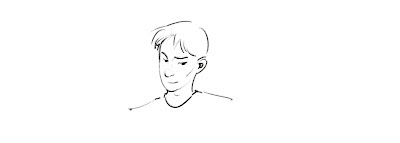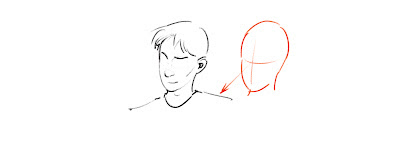Today we will talk about using faces and eyes in our pictures, or how to....
Thanks, Mr. Announcer guy!
Before I get into this, let's remember a couple basic composition principles:
Basic Composition Principles
We use some objects that act like targets. They attract the eyes of the viewer.
We use other objects that act like arrows. They point to something (often a target object).
A good composition should act like this: the arrow object points our eyes to the target and we viewers find our attention riveted on whatever that target is. The goal is to develop a good "balance" in the picture. We put the target in a nice spot for our eyes to rest within the picture. We place arrows so that they point into the picture and not out of it, toward the target and not away from it.
Principles Applied to Faces and Eyes
Faces are great example of target objects. Artists and photographers like to use faces to attract attention. We viewers usually don't mind, being partial to our likeness. In fact, even if the artist does not intend for us to look at a face, the viewer will look at it involuntarily. Faces innately attract our attention.
And yet, while faces always attract, sometimes they also double as arrow objects! A turned head can turn our heads and point us in a direction.
Perhaps its the nose that does the pointing....
The trick with faces is to "balance" the targetness and arrowness within the picture. If a face is pointing in one direction, make sure it has space there to make up for the strong directional prompt. If it is too close to the edge of the picture, it will point our eyes out and away!
The eye is a perfect example of a target object. That dark center with the rings around it... It can powerfully attract our attention.
And yet....
It too can powerfully direct our attention! The eyes act as arrow objects most often in pictures, pointing at the object of interest.
Combining Face and Eye Directions
When heads and eyes direct the viewer's attention in a picture, they often act in unison.
With both pointing in the same direction, the artist does not have to worry about where the viewer will look.
However, sometimes the face and eyes act independently.
If you ignore the eyes here, the head is pointing down and to the left (his right).
However, his eyes point down and to the right. (His left.)
A good rule of thumb is to let the eye direction overrule the head direction. While we are interested in a person, we are more interested in what a person is thinking about. When we see someone suddenly look in a direction, we sometimes catch ourselves involuntarily looking to see what caught their attention.
Again, this pose could confuse the artist. Where is a good place to put this head in the picture?
The head is pointing down and right in the picture, almost away from us...
...but the eyes are pointing toward us and to the left.
Remember: eyes overrule faces. Just wanted to make sure that you got that.
Practical Problem: Something's Stirring Out There
This picture has major problems. It almost looks like random sketches—like the people are not really interacting.
The only reason that it somehow works is that the directional gaze of the two characters on the left is counteracted by the stirring woman's gaze. Other than her self-consumed part of the picture, the two men on the left gaze strongly out of the picture.
A better picture might look like this.
By using the young man as the center of interest, and having both characters looking at him, the composition get better instantly. All of a sudden the characters are interacting meaningfully within the picture.
If we turned the man's head a little, it helps even more...
Other than having a creepy mad scientist (or whatever he is), this picture also has compositional issues. While both of the men are looking at the object of interest, that object is too far over in the picture.
The test tube that the assistant is holding acts as the target. (It doesn't look like one... but don't think about that, right now.) Unfortunately for this picture, the test tube is too close to the left edge. With the strong directional gaze from both of the characters, the effect is very powerful. The test tube is not a strong enough target, and the strength of their look carries the compositional force out of the picture.
If we merely flip our lab assistant around, the composition instantly gets much better.
The test tube is in a much better spot, compositionally. Both gazes now intersect on it, creating a much better picture.
Also note: if we change the assistant's gaze just a little bit, the composition changes. The assistant becomes the center of interest, and the picture now becomes a story not of a laboratory surprise but of the character differences between the mad scientist and his assistant! Always look for ways for the people to interact in your compositions.
Practical Problem: Off Center
Ok, one last compositional problem.
This one is interesting because each of the faces acts as targets.
However, the eyelines create problems, leading eventually out of the picture to the left.
If we move a couple of the eyes, we can make a different dynamic in this picture. Almost a circular pattern... around and around...
By doing this, the little guy who is trying to play basketball becomes the compositional center, creating a fun dynamic of personalities.
Addendum
Of course, the artist can break the rules. You just can't find an inscribed stone proclaiming, "Thou shalt balance the eye and face directional forces within your picture's composition."
Especially in sequential art (comics or animation), movement over time allows artists to experiment with misdirection and other compositional tricks.
However, break the rules at your own peril. Your picture may suffer the consequences....



































